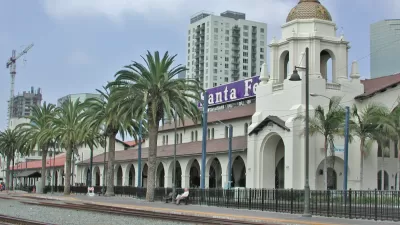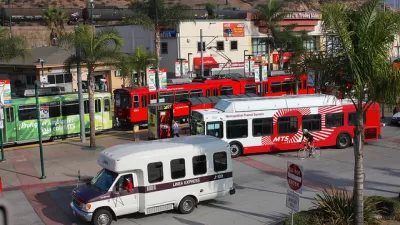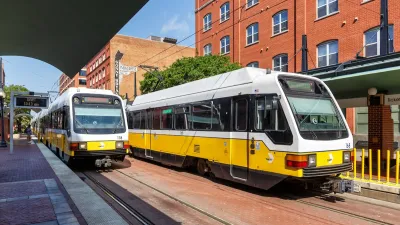The San Diego Association of Government on October 9 will consider a 35-year regional plan that prioritizes public transit in its management of an expected 1 million new residents.

"A new long-term blueprint from area planners puts skyways and light rail stations in some of the county’s beach communities," reports Joshua Stewart, "making it possible for people who want to get to the ocean to make the trip from most of the county without getting behind the wheel."
That's the lede from a 35-year plan from the San Diego Association of Government (SANDAG). San Diego Forward: The Regional Plan, as its known, plans for the addition of 1 million new residents by 2050.
As for the organizing principles that will shape the region's approach to that growth: "The blueprint is built on the assumption that suburban sprawl will be curtailed, more people will live closer to where they work and along transportation corridors. There will be a significant shift in the number of households in multifamily homes. Neighborhoods will be more densely populated, and it will be easier to use mass transit like trolleys and skyway gondolas."
Also included is a "balanced" approach to transportation needs that would spend about half of an envisioned $204 billion in transportation spending on public transit, "new light rail lines, skyways and buses..." The article goes into a lot more detail about how the plan sets transportation priorities over the next 35 years.
FULL STORY: How we'll travel: Trains, lanes, bikes and gondolas

Alabama: Trump Terminates Settlements for Black Communities Harmed By Raw Sewage
Trump deemed the landmark civil rights agreement “illegal DEI and environmental justice policy.”

Planetizen Federal Action Tracker
A weekly monitor of how Trump’s orders and actions are impacting planners and planning in America.

The 120 Year Old Tiny Home Villages That Sheltered San Francisco’s Earthquake Refugees
More than a century ago, San Francisco mobilized to house thousands of residents displaced by the 1906 earthquake. Could their strategy offer a model for the present?

In Both Crashes and Crime, Public Transportation is Far Safer than Driving
Contrary to popular assumptions, public transportation has far lower crash and crime rates than automobile travel. For safer communities, improve and encourage transit travel.

Report: Zoning Reforms Should Complement Nashville’s Ambitious Transit Plan
Without reform, restrictive zoning codes will limit the impact of the city’s planned transit expansion and could exclude some of the residents who depend on transit the most.

Judge Orders Release of Frozen IRA, IIJA Funding
The decision is a victory for environmental groups who charged that freezing funds for critical infrastructure and disaster response programs caused “real and irreparable harm” to communities.
Urban Design for Planners 1: Software Tools
This six-course series explores essential urban design concepts using open source software and equips planners with the tools they need to participate fully in the urban design process.
Planning for Universal Design
Learn the tools for implementing Universal Design in planning regulations.
Clanton & Associates, Inc.
Jessamine County Fiscal Court
Institute for Housing and Urban Development Studies (IHS)
City of Grandview
Harvard GSD Executive Education
Toledo-Lucas County Plan Commissions
Salt Lake City
NYU Wagner Graduate School of Public Service





























